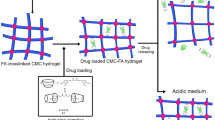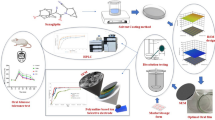Abstract
A well-designed drug delivery platform improves the pharmacological properties of therapeutics. Here, we report a biodegradable interpenetrating polymer network (IPN) microbeads delivery technology developed by crosslinking a polymer blend of poly(vinyl alcohol), xanthan gum, and sodium alginate to enhance the solubility of poorly soluble drugs. The microbeads effectively improve the solubility of a model BCS Class IV drug, norfloxacin, known for its low solubility and low permeability. Differential scanning calorimetry, powdered X-ray diffractometry, and FT-IR data showed that the IPN microbeads solubilised and encapsulated the drug within the network. We found over 83% encapsulation efficiency for norfloxacin and this efficiency increases with the concentration of polymer. Ex vivo experiments using caprine intestine revealed that the IPN microbeads adhered to the intestinal epithelium, a mucoadhesive behaviour that could be beneficial to the drug pharmacokinetics while in vitro experiments in phosphate buffer show that the IPN enables significant drug release. We believe that these IPN microbeadsare an excellent drug delivery system to solubilise norfloxacin, ensure adhesion to the intestinal wall, thereby localising the drug release to enhance bioavailability of poorly soluble drugs.

Graphical abstract














Similar content being viewed by others
References
Li J, Mooney DJ (2016) Designing hydrogels for controlled drug delivery. Nat Rev Mater 1:16071
Mehmood Y, Riaz H, Barkat K, Yousaf H, Malik AR, Raza SA (2019) Fabrication of HPMC and Hibiscus esculentus (okra) gum based microspheres loaded with sulfasalazine and dexamethasone. J Polym Res 26(6):130
Gao JG, Zhang Y, Yu YF, Han YC, Zhang BZ, Gao CH (2011) Preparation of chitosan microspheres loading of 3, 5-dihydroxy-4-i-propylstilbene and in vitro release. J Polym Res 18(6):1501–1508
Chu IM, Liu TH, Chen YR (2019) Preparation and characterization of sustained release system based on polyanhydride microspheres with core/shell-like structures. Journal of Polymer Research 26(1):1
Shin BY, Cha BG, Jeong JH, Kim J (2017) Injectable microporous ferrogel microbeads with a high structural stability for magnetically actuated drug delivery. ACS Appl Mater Interfaces 9:31372–31380
Bannerman D, Wan W (2016) Multifunctional microbeads for drug delivery in TACE. Expert Opin Drug Deliv 13:1289–1300
Shaji J, Chadawar V, Talwalkar P (2007) Multiparticulate drug delivery system. The Indian Pharmacist 6(60):21–28
Kulkarni AR, Soppimath KS, Aminabhavi TM, Rudzinski WE (2001) In-vitro release kinetics of cefadroxil-loaded sodium alginate interpenetrating network beads. Eur J Pharm Biopharm 51(2):127–133
Roy P, Shahiwala A (2009) Multiparticulate formulation approach to pulsatile drug delivery: current perspectives. J Control Release 134(2):74–80
Sood A, Panchagnula R (2003) Design of controlled release delivery systems using a modified pharmacokinetic approach: a case study for drugs having a short elimination half-life and a narrow therapeutic index. Int J Pharm 261(1–2):27–41
Laila FAA, Chandran S (2006) Multiparticulate formulation approach to colon specific drug delivery current perspectives. J Pharm Pharm Sci 9(3):327–338
Butler J, Cumming I, Brown J, Wilding I, Devane JG (1998) A novel multiunit controlled-release system. Pharm Technol 22:122–138
Yin ZC, Wang YL, Wang K (2018) A pH-responsive composite hydrogel beads based on agar and alginate for oral drug delivery. J Drug Deliv Sci Technol 43:12–18
Yang W, Fortunati E, Bertoglio F, Owczarek JS, Bruni G, Kozanecki M, Kenny JM, Torre L, Visai L, Puglia D (2018) Polyvinyl alcohol/chitosan hydrogels with enhanced antioxidant and antibacterial properties induced by lignin nanoparticles. Carbohydr Polym 181:275–284
Park JS, Park JW, Ruckenstein E (2001) A dynamic mechanical and thermal analysis of unplasticized and plasticized poly (vinyl alcohol)/methylcellulose blends. A dynamic mechanicaland thermal analysis of unplasticized and plasticized poly (vinyl alcohol)/methylcellulose blends
Traore YL, Fumakia M, Gu J, Ho EA (2018) Dynamic mechanical behaviour of nanoparticle loaded biodegradable PVA films for vaginal drug delivery. J Biomater Appl 32(8):1119–1126
Mendes AC, Strohmenger T, Goycoolea F, Chronakis IS (2017) Electrostatic self-assembly of polysaccharides into nanofibers. Colloids Surfaces A Physicochem Eng Asp 531:182–188
Shekarforoush E, Ajalloueian F, Zeng G, Mendes AC, Chronakis IS (2018) Electrospun xanthan gum-chitosan nanofibers as delivery carrier of hydrophobic bioactives. Mater Lett 228:322–326
Liu R (2008) Water-insoluble drug formulation. CRC Press
Sintra TE, Shimizu K, Ventura SP, Shimizu S, Lopes JC, Coutinho JA (2018) Enhanced dissolution of ibuprofen using ionic liquids as catanionichydrotropes. Phys Chem Chem Phys 20(3):2094–2103
Jain P, Goel A, Sharma S, Parmar M (2010) Solubility enhancement techniques with special emphasis on hydrotropy. J Pharma Prof Res 1:34–45
Sharma DK, Joshi SB (2007) Solubility enhancement strategies for poorly water-soluble drugs in solid dispersion: a review. Asian J Pharm 1:9–19
Kalepu S, Nekkanti V (2015) Insoluble drug delivery strategies: review of recent advances and business prospects. Acta Pharm Sin B 5:44–453
Brown SA (1996) Fluoroquinolones in animal health. J Vet Pharmacol Ther 19:1–14
Preheim LC, Cuevas TA, Roccaforte JS, Mellencamp MA, Bittner MJ (1987) Oral use of ciprofloxacin in the treatment of elderly patients with complicated urinary tract infections due to trimethoprim sulfamethoxazole-resistant bacteria. Am J Med 82:295–297
Bera H, Boddupalli S, Nayak AK (2015) Mucoadhesive-floating zinc-pectinate-sterculia gum interpenetrating polymer network beads encapsulating ziprasidoneHCl. Carbohydr Polym 131:108–118
Lanzerstorfer C (2017) Dusts from dry off-gas cleaning: comparison of flowability determined by angle of repose and with shear cells. Granul Matter 19:1–7
Keely S, Rullay A, Wilson C, Carmichael A, Carrington S, Corfield A, Haddleton DM, Brayden DJ (2005) In vitro and ex vivo intestinal tissue models to measure mucoadhesion of poly(methacrylate) and N-trimethylated chitosan polymer. Pharm Res 22:38–49
Nayak AK, Pal D, Santra K (2014) Development of calcium pectinate-tamarind seed polysaccharide mucoadhesive beads containing metformin HCl. Carbohydr Polym 101:220–230
Nayak AK, Pal D, Santra K (2014) Development of pectinate-ispagula mucilage mucoadhesive beads of metformin HCl by central composite design. Int J Biol Macromol 66:203–211
Nayak AK, Pal D, Das S (2013) Calcium pectinate-fenugreek seed mucilage mucoadhesive beads for controlled delivery of metformin HCl. Carbohydr Polym 96:349–357
Kim CK, Lee EJ (1992) The controlled release of blue dextran fromalginate beads. Int J Pharm 79:11–19
Mohamadnia Z, Zohuriaan-Mehr MJ, Kabiri K, Jamshidi A, Mobedi H (2007) pH-sensitive IPN hydrogel beads of carrageenan-alginate for controlled drug delivery. J Bioact Compat Polym 22(3):342–356
Kulkarni AR, Soppimath KS, Aminabhavi TM, Dave AM (2002) Polymeric sodium alginate interpenetrating network beads for the controlled release of chlorpyrifos. J Appl Polym Sci 85(5):911–918
Garoushi S, Vallittu PK, Watts DC, Lassila LV (2008) Polymerization shrinkage of experimental short glass fiber-reinforced composite with semi-inter penetrating polymer network matrix. Dental Materials 24(2):211–215
Rumondor AC, Ivanisevic I, Bates S, Alonzo DE, Taylor LS (2009) Evaluation of drug-polymer miscibility in amorphous solid dispersion systems. Pharm Res 26(11):2523–2534
Narkar M, Sher P, Pawar A (2010) Stomach-specific controlled release gellan beads of acid-soluble drug prepared by ionotropic gelation method. AAPS PharmSciTech 11(1):267–277
Guo T, Zhang N, Huang J, Pei Y, Wang F, Tang K (2018) A facile fabrication of core–shell sodium alginate/gelatin beads for drug delivery systems. Polym Bull 1–16
Javanbakht S, Pooresmaeil M, Hashemi H, Namazi H (2018) Carboxymethylcellulose capsulated Cu-based metal-organic framework-drug nanohybrid as a pH-sensitive nanocomposite for ibuprofen oral delivery. Int J Biol Macromol
Gamboa JM, Leong KW (2013) In vitro and in vivo models for the study of oral delivery of nanoparticles. Adv Drug Deliv Rev 65(6):800–810
Viseras C, Cerezo P, Bedmar MC (2008) Biopolymer–clay nanocomposites for controlled drug delivery. Mater Sci Technol 24:1020–1026
Silva BMA, Borges AF, Silva C, Coelho JFJ, Simoes S (2015) Mucoadhesive oral films: the potential for unmet needs. Int J Pharm 494:537–551
Banerjee A, Mitragotri S (2017) Intestinal patch systems for oral drug delivery. Curr Opin Pharmacol 36:58–65
Gombotz W, Wee S (1998) Protein release from alginate matrices. Adv Drug Deliv Rev 31:267–285
Gaserod O, Jolliffe I, Hampson F, Dettmar P, Skjak-Bræk G (1998) The enhancement of the bioadhesive properties of calcium alginate gel beads by coating with chitosan. Int J Pharm 175(2):237–246
Barzegar-Jalali M, Hanaee J, Omidi Y, Ghanbarzadeh S, Ziaee S, Bairami-Atashgah R, Adibkia K (2013) Preparation and evaluation of sustained release calcium alginate beads and matrix tablets of acetazolamide. Drug Res 63(02):60–64
Martin A, Bustamante P, Chun AHC (1993) In: Martin A (ed) Physical pharmacy: physical chemical principles in the pharmaceutical sciences4th edn. Lea and Febiger, Philadelphia, pp 284–323
Ghosal K, Ranjan A, Bhowmik BB (2014) A novel vaginal drug delivery system: anti-HIV bioadhesive film containing abacavir. J Mater Sci Mater Med 25(7):1679–1689
Ghosal K, Rajabalaya R, Maiti AK, Chowdhury B, Nanda A (2010) Evaluation of physicochemical properties and in-vitro release profile of glipizide-matrix patch. Braz J Pharm Sci 46(2):213–218
Ghosal K, Ray SD (2011) Alginate/hydrophobic HPMC (60M) particulate systems: new matrix for site-specific and controlled drug delivery. Braz J Pharm Sci 47(4):833–844
Sankalia MG, Mashru RC, Sankalia JM, Sutariya VB (2005) Papain entrapment in alginate beads for stability improvement and site-specific delivery: physicochemical characterization and factorial optimization using neural network modeling. Aapspharmscitech 6(2):E209–E222
Salomon J-L, Doelker E (1980) Formulation des comprimes a liberation prolongee. Pharm Acta Helv 55:174–182
El-Arini SK, Leuenberger H (1995) Modeling of drug release frompolymer matrices: effect of drug loading. Int J Pharm 121:141–148
Costa P, Lobo JMS (2001) Modeling and comparison of dissolution profiles. Eur J Pharm Sci 13(2):123–133
Ghosal K, Chandra A, Rajabalaya R, Chakraborty S, Nanda A (2012) Mathematical modeling of drug release profiles for modified hydrophobic HPMC based gels. Die Pharmazie-An International Journal of Pharmaceutical Sciences 67(2):147–155
McDonald BF, Coulter IS, Marison IW (2015) Microbeads: a novel multiparticulate drug delivery technology for increasing the solubility and dissolution of celecoxib. Pharm Dev Technol 20(2):211–218
Acknowledgements
K.G. thanks the Dr. B. C. Roy College of Pharmacy and Allied Health Sciences, Dr. Meghnad Saha Sarani, Bidhan Nagar, Durgapur 713206, West Bengal, India for providing the infrastructural and research facilities. P.G thanks the postdoctoral fellowship under KSCSTE-PDF scheme, Government of Kerala. Award No: KSCSTE/5209/2017-PDF.
Author information
Authors and Affiliations
Corresponding authors
Additional information
Publisher’s note
Springer Nature remains neutral with regard to jurisdictional claims in published maps and institutional affiliations.
Rights and permissions
About this article
Cite this article
Ghosal, K., Adak, S., Agatemor, C. et al. Novel interpenetrating polymeric network based microbeads for delivery of poorly water soluble drug. J Polym Res 27, 98 (2020). https://doi.org/10.1007/s10965-020-02077-6
Received:
Accepted:
Published:
DOI: https://doi.org/10.1007/s10965-020-02077-6




